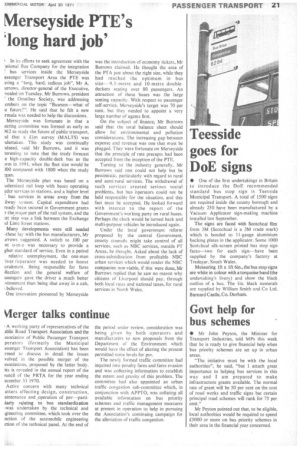Merseyside PTV s 'long hard job'
Page 23

If you've noticed an error in this article please click here to report it so we can fix it.
In its efforts to seek agreement with the 'ational Bus Company for the integration ; bus services inside the Merseyside assenger Transport Area the PTE was lying a "long, hard, tedious job", Mr A. urrows. director-general of the Executive, ivealed on Tuesday. Mr Burrows, president ' the Omnibus Society, was addressing embers on the topic "Busmen—what of Le future?". He said that he felt a new irmula was needed to help the discussions. Merseyside was fortunate in that a erring committee was formed as early as )62 to study the future of public transport, id that a survey (MALTS) was idertaken. This study was continually 'dated, said Mr Burrows, and it was teresting to note that the study forecast .e high-capacity double-deck bus as the )rm in 1991, when the fleet size would be )00 compared with 1800 when the study ;gam The Merseyside plan was based on a odernizcd rail loop with buses operating eder services to stations, and a higher level ' bus services in areas away from the .ilway system. Capital expenditure had ready been secured in Government grants r the major part of the rail system, and the :xt step was a link between the Exchange ld Lime Street stations.
Many developments were still needed these lay with the bus manufacturers, Mr arrows suggested. A switch to 100 per nt o-m-o was necessary to provide a gher standard of service. Even in a period • relative unemployment, the one-man iver /operator was needed to boost cruitment. Being responsible for fares ollection and the general welfare of tssengers gave the driver a _much better nironment than being shut away in a cab, believed, • One innovation pioneered by Merseyside was the introduction of economy tickets, Mr Burrows claimed. He thought the area of the PTA just about the right size, while they had reached the optimum in bus size--9.5-metre and 10-metre doubledeckers seating over 80 passengers. An attraction of these buses was the large seating capacity. With respect to passenger self-service, Merseyside's target was 70 per tent, but they needed to appoint a very large number of agents first.
On the subject of finance, Mr Burrows said that the total balance sheet should allow for environmental and pollution considerations. The increasing gap between expense and revenue was one that must be plugged. They were fortunate on Merseyside that the principle , of rate precepts had been accepted from the inception of the PTE.
Turning to the industry generally, Mr Burrows said one could not help but be pessimistic, particularly with regard to rural and semi-rural services. The withdrawal of such services created serious social problems, but bus 'operators could not be held responsible for the situation, and this fact must be accepted. He looked forward with interest to the report of the Government's working party on rural buses. Perhaps the clock would be turned back and multi-purpose vehicles be introduced again.
Under the local government reform proposed by the central Government, county councils might take control of all services, such as NBC services, outside PT Areas, he thought. Asked about the lack of cross-subsidization from profitable NBC urban services which would render the NBC companies non-viable, if this were done, Mr Burrows replied that he saw no reason why citizens of Liverpool should pay, through both local rates and national taxes, for rural services in North Wales.




























































































